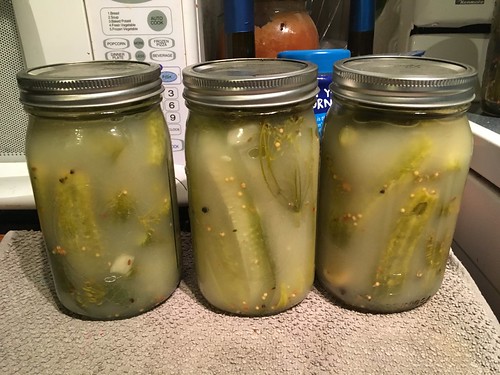Nothing exemplifies this more than peaches. There are few desserts Emma likes more than canned peaches, and opening a home-canned jar in January can't be beat. So last weekend when we got home from the fiber festival I canned the two boxes I bought the week before, about 50 pounds of Elberta peaches. Yum and double yum.

I have also made two small batches of pickles. These are cukes from Anne's garden, after she decided that the approximately 40 quarts (I think?) of pickles she made this year was enough and she couldn't face making any more.
Rather than making regular vinegar pickles this time around, I decided to copy Anne and make lacto-fermented ones. My mom used to occasionally make these in a big crock, but not having enough cukes to fill the crock, I opted for jars like Anne.
It's just cucumbers, a salt brine, and whatever spices you want. The first batch I made according to Anne's favorite recipe (Mrs. Neusihin's recipe of Pacific Northwest fame), with garlic, dill, dry mustard, pickling spice, a grape leaf, a chunk of fresh horseradish and a hot pepper. For the second batch I left out the horseradish and hot pepper, because I don't like spicy and I was scared. I tried Anne's pickles when I was there a few weeks ago, and liked them, but still... horseradish and hot pepper...
So you put everything in a jar, lid it loosely, and leave it on the counter. Then a couple times a day you tighten the lids and give the jars a shake, then re-loosen the lids to let the fermentation gasses escape.
When they start, the liquid is clear and the cucumbers are bright green. This is the second batch on Day 1.

Over the course of a week or so, the beneficial bacteria grows in the brine and makes it cloudy, while the cucumbers turn into pickles and become pickle-green. When they are to your desired sourness, you tighten the lids and they are done. I put mine in the fridge, which stops the fermentation. This is what the first batch looked like at the end of Day 6.

For the best flavor, it's good to let them ripen for at least 4 to 6 weeks before eating. That means our first batch will be ready to eat at the end of October. They smell fantastic, and we're having a hard time waiting.

No comments:
Post a Comment